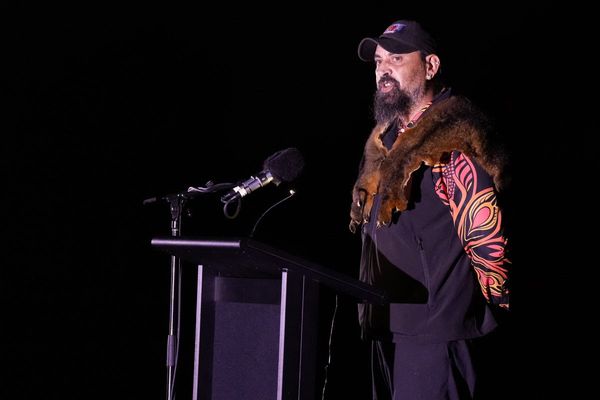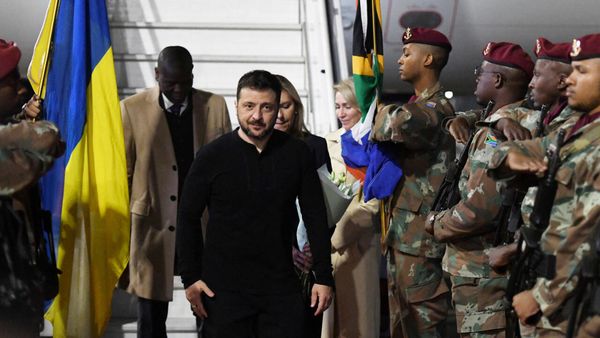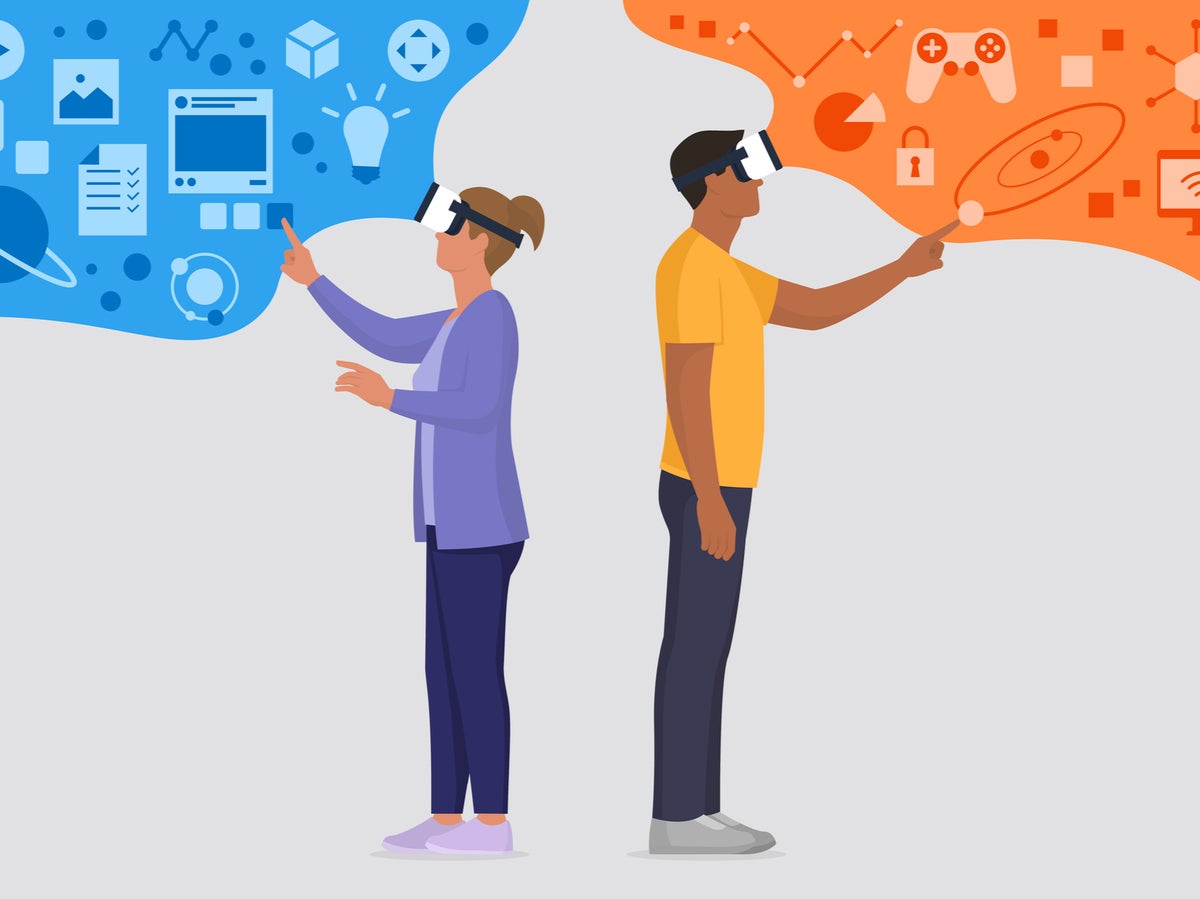
On our first date, CC and I meet on a floating platform suspended in the middle of a distant galaxy. As with much space travel, we experience a few technical difficulties. CC – as they’ve asked to be called – is supposed to be a rabbit, but they look to me like a small animated girl in a hoodie with large cat ears and a tail. My voice is on a delay that disrupts the natural flow of conversation. And for several minutes, my body – that of a lanky blonde woman in a cropped puffer jacket and leggings – crawls around in a half-squat, like a terrier looking for the right spot to relieve itself.
“I’m sorry,” I hear my voice say a couple of seconds after I had actually apologised. “I don’t know why this is happening.”
“Don’t apologise!” CC says. They have seen much weirder things before, they assure me. Such was the nature of interacting in virtual reality.
I had matched with CC a week earlier on Nevermet, one of a growing number of virtual reality (VR) dating services that allow users to match with other VR enthusiasts and then arrange a meetup somewhere in the metaverse. There’s also Flirtual, which promises “safe, magical dates in VR.” There’s Second Life’s Lonely Hearts Dating Agency. Even Match Group, the company behind apps such as Match, OkCupid, Tinder and Hinge, announced in November that it would be launching Single Town, a virtual space where singles can meet and organise pixelated rendezvous.
All it takes to go on a VR date is a fully charged headset and an open heart, and you and your companion could enjoy a never-ending beach sunset in VRChat’s Serenity Cove or roam around a post-apocalyptic landscape in Race Against Fate. You could play freeze tag in a world with magical, moving walls or flirt in an underwater lair surrounded by gigantic, alien jellyfish. You could also just meet up at a bar — a popular VR date option, I’m told.
Nevermet launched on Valentine’s Day of this year, and its goal was simple: to completely reconfigure human nature. “We intend to change the dating market, where physical attraction will become one of several factors rather than the primary way people connect,” Nevermet CEO Cam Mullen tells me over the phone.
Dating now is too focused on looks, Mullen argues. With VR, humans can finally evolve beyond the superficial and instead connect with each other on a deeper level – heart-to-heart, spirit-to-spirit.
Nevermet’s interface is similar to those of other dating apps such as Tinder or Bumble, but instead of photos of a toothy laugh at a friend’s wedding or a triumphant hoist of a striped bass, users’ profiles show their metaverse avatars. Instead of bios that say they’re looking for an “adventure buddy,” users often include their VRChat and Discord usernames and a list of their favourite VR games.
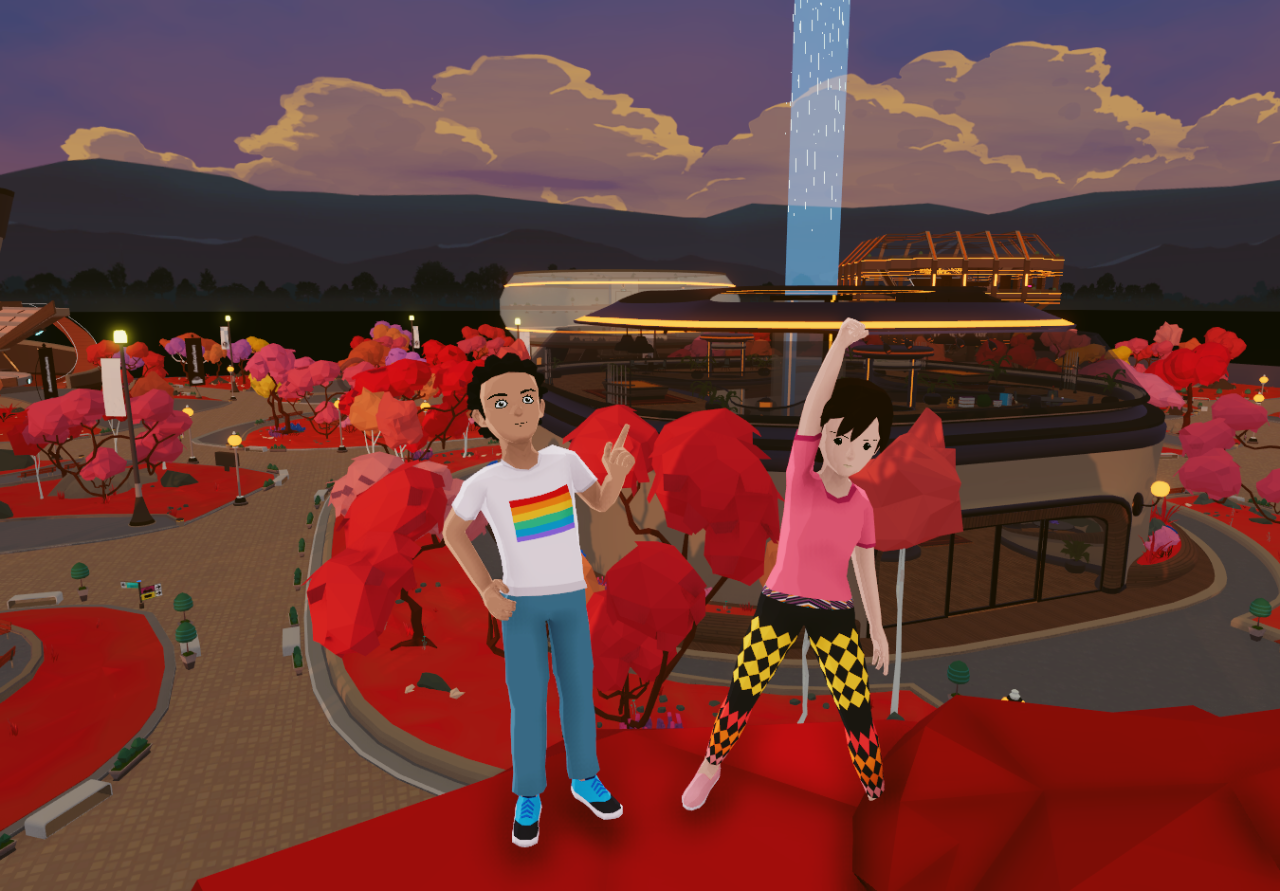
Looks do still come into play, of course. Lots of users want to connect with someone whose avatar is a doe-eyed woman in micro-jorts – or perhaps a hypermasculine beefcake with mandibles that splay out and away from his mouth like bat wings. But just as many want to connect with a nice humanoid fox who shares a passion for houseplants or with a faceless demon who has a full set of sharp teeth and a healthy communication style. I was surprised by how many matches I made using my first avatar – a giant, smiling mushroom that I later abandoned when a man with a bunny avatar told me that he associated mine with children.
Even before savvy developers began putting out apps for the metaverse, there was already a thriving social scene in it, one I’m told is often full of drama, intrigue, binge-drinking and ERP (erotic role play — in essence, VR sex).
VR regulars I speak with describe metaverse friend groups that are Gordian knots of romantic tension, with different people hooking up every day. There are also VR clubs, which are popular spaces for people to go drink and party.
One woman describes being at a DJ event at one such club and seeing avatars passed out on the VR floor, presumably because their human counterparts had overindulged at home.
“It’s kind of bad because I don’t think people realise that technically you’re not alone, but you are alone,” she says.
The clubs can also be popular spaces to hook up, an exhibitionism looked down upon by some. In one YouTube video discussing the merits of ERP (pros: It feels more immersive than porn; cons: It’s not as good as real sex), one VR user the hosts interview express not having qualms with virtual sex so long as it didn’t take place in public VRChat spaces.
Already, many VR users say they experience ‘phantom touch’ – feeling physically what is happening to their VR avatars. Some people say that when their arms are touched in VR, they can feel it
“It’s cliquey,” Stonie Blue, 23, says of the VR dating scene. “It’s like high school drama but from people who are very much out of high school.”
Blue met his wife, Elaine Karapetian, 27, in VR; both are creators in VRChat. They initially bonded over their love of the band 100 Gecs and became close when Blue helped Karapetian navigate a series of emotional entanglements. As Blue puts it: “It turns out the solution to her boy problems was a different boy, and that was me.”
Soon, Blue and Karapetian were confronted with the fact that one of the biggest pluses of VR dating – that you can meet people from all over the world – is also one of its biggest downsides. When they met, Blue lived in Newcastle and Karapetian lived in Wisconsin. Even though they spend a lot of their time in VR, it was important for both of them to meet in person as soon as possible to see whether they really were compatible enough to seriously date.
In May 2021, Karapetian flew to the UK, and, fortunately, everything went swimmingly. Then, the couple discovered another major drawback of VR dating: hanging out with someone in VR may seem close to the real thing, but it’s just not the same.
“Once you meet someone physically, VR doesn’t cut it anymore,” Blue says. Their first time in VR together after Karapetian left the UK was miserable. “We cried with each other because it was that sad. It was, like, this sucks, I don’t want to be in VR.”
Less than a year later, Blue travelled to the United States, and he and Karapetian got married. Now, Karapetian is waiting for her visa to move to the UK. As important as spending time together in real life has been for the couple, Karapetian says she knows a lot of people who would rather keep their VR dating experience entirely online.
“The people I do know that date in VR, it seems like a lot of them don’t ever meet up, or it seems like it’s in the game.”
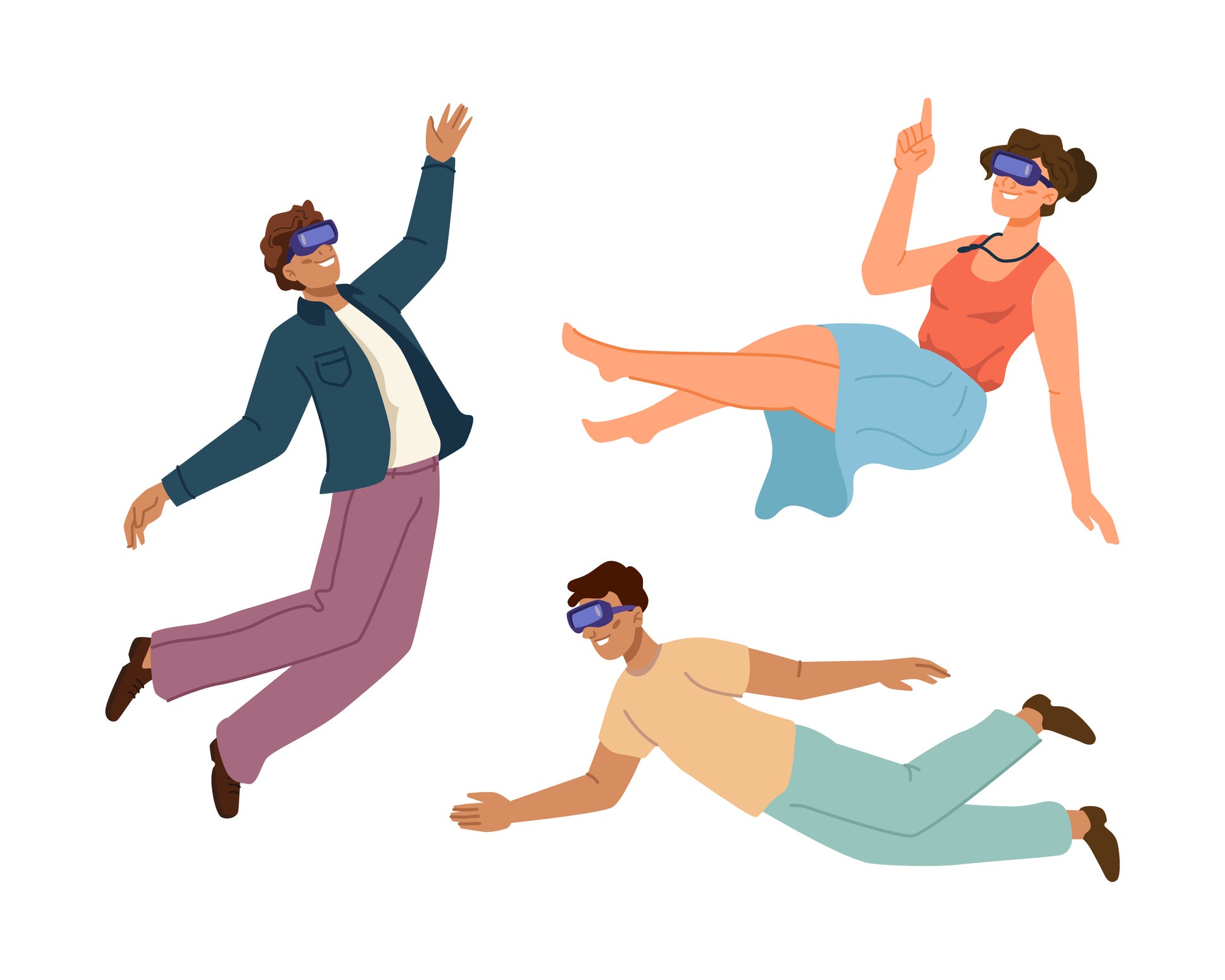
On Nevermet, Mullen says that although the majority of its users imagine meeting up in the real world one day, “they also believe that one day, virtual reality will be so immersive that more and more relationships will flourish online.”
Already, many VR users say they experience “phantom touch” – feeling physically what is happening to their VR avatars. Some people say that when their arms are touched in VR, they can feel it on their real arms. This phenomenon is especially relevant in ERP but can also serve to deepen feelings that arise with more chaste contact as well. Blue recalls a moment, before they started dating, when he and Karapetian were patting each other’s heads, a popular form of VR contact. “I was sitting there, and she petted my face, and I was like, this is super intimate.”
Among non-VR users who choose to remain firmly rooted in the real world and take advantage of all the wonders that in-person dating has to offer – such as complicated scheduling, upper-lip sweat and blisters from the new shoes they chose to wear because they didn’t realise the concert would be standing room only – there can be a tendency to dismiss VR. Some suggest it is a way for people to bury their heads in the sand instead of engaging with the often-uncomfortable work of being a human who is looking for love in the world.
Take the response to We Met in Virtual Reality, a new HBO documentary about VR dating. When the trailer was released on Twitter in July, Blue recalls seeing a lot of snark online. There were comments such as “this is cringe” and “why don’t they just go outside?”
But for a lot of VR users, having access to a flourishing dating life online isn’t a way to avoid the wider world; it’s a way to access it.
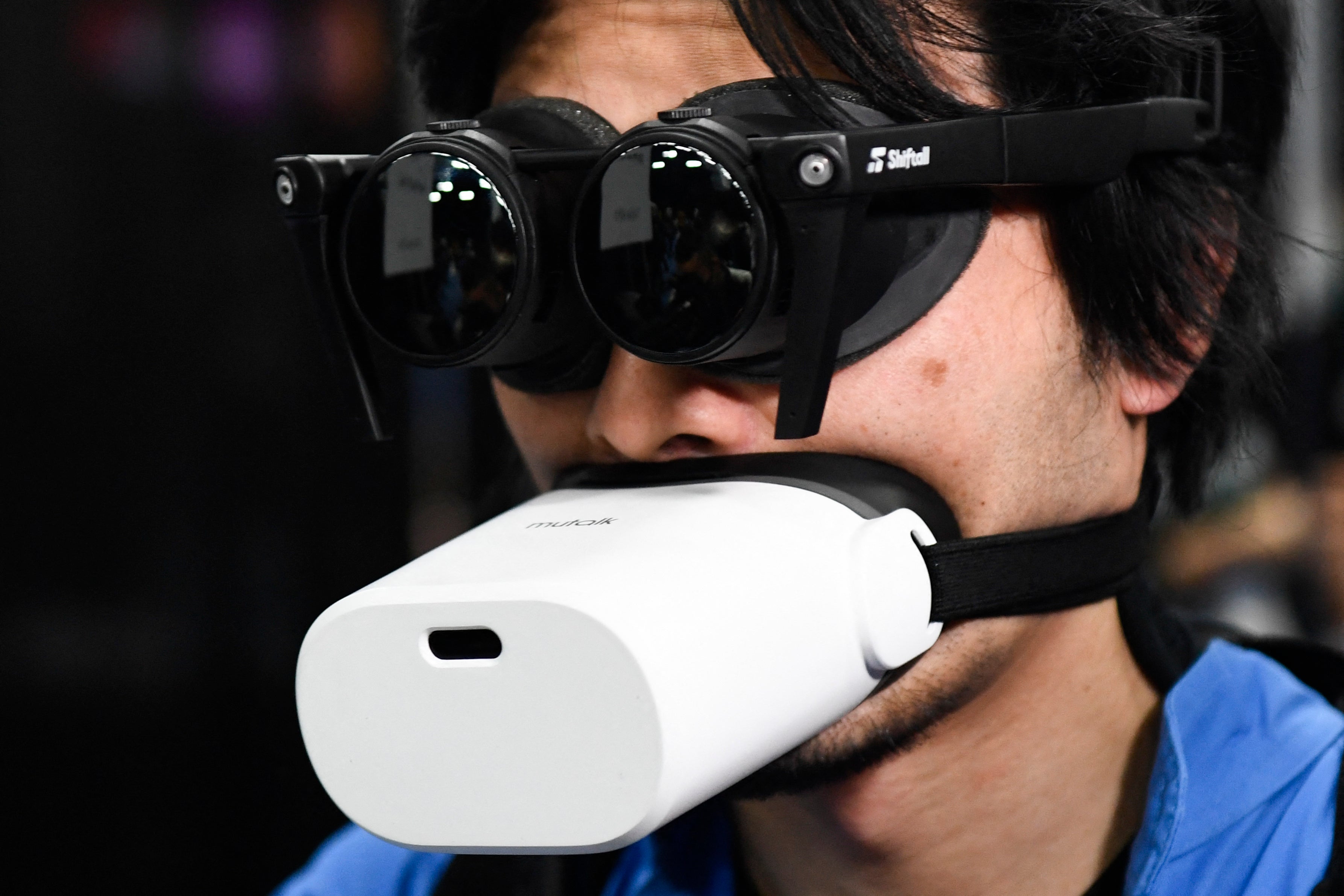
“Many of our users live in small towns,” Mullen says. “Some travel for the military. Some have social anxiety in the physical world in social situations. Some are confined to assisted living. People can sometimes feel like their best self in these virtual forms.”
VR can also be a space for users to safely experiment with their sexual identity and/or gender expression. According to Anthony Tan, co-creator of Flirtual, the majority of its users are between the ages of 18 and 30, and 50 per cent of their users identify as LGBTQ+.
Before she transitioned, Karapetian says she would sometimes go into a private VR world and switch to a female avatar for a while. She also met a lot of friends in VRChat who are trans and who helped her feel safe enough to move forward with her own transition.
“Before VR, I was in an environment that was not very accepting,” she says. “What VR did for me was give me a group of people that made it OK to explore.”
Back in outer space, CC and I play a knockoff version of Beat Saber, a popular VR game that lets you slash through coloured blocks with light sabres to the beat of different songs. It is fun, and I only smash my coffee table once. CC is charming, easy to talk with and eager to help me navigate the complexities of VR. CC actually shows up to our date, unlike the first person I matched with on Nevermet, who texted me an hour after the appointed time to say sorry for losing track of time. It was the first time I had ever been stood up, in VR or in person, and though annoying, I was grateful I didn’t need to leave my couch for it.
Admittedly, my intergalactic meeting with CC isn’t really a date. When we first matched, I explained that I was a journalist writing a story, and they gamely agreed to show me around. It’s probably for the best anyway. CC tells me they had recently started seeing someone in VR – the first person they had matched with on Nevermet, actually. It’s not “super official,” but “the relationship” is going well. The two live only about an hour and a half away from each other in real life, but CC hemmed and hawed when I ask whether they had plans to meet up. “Part of it is health concerns on my end with the pandemic,” CC says.
CC says they had noticed a big uptick in VR users during the pandemic. VR seems like it would be an appealing technology for those stuck at home with money and time to spare – an easy way to escape the banality and horror of the real world and to connect with others without the risk of inhaling harmful viruses. And if you can meet new people and flirt with them and go on dates to exotic locations? All the better.
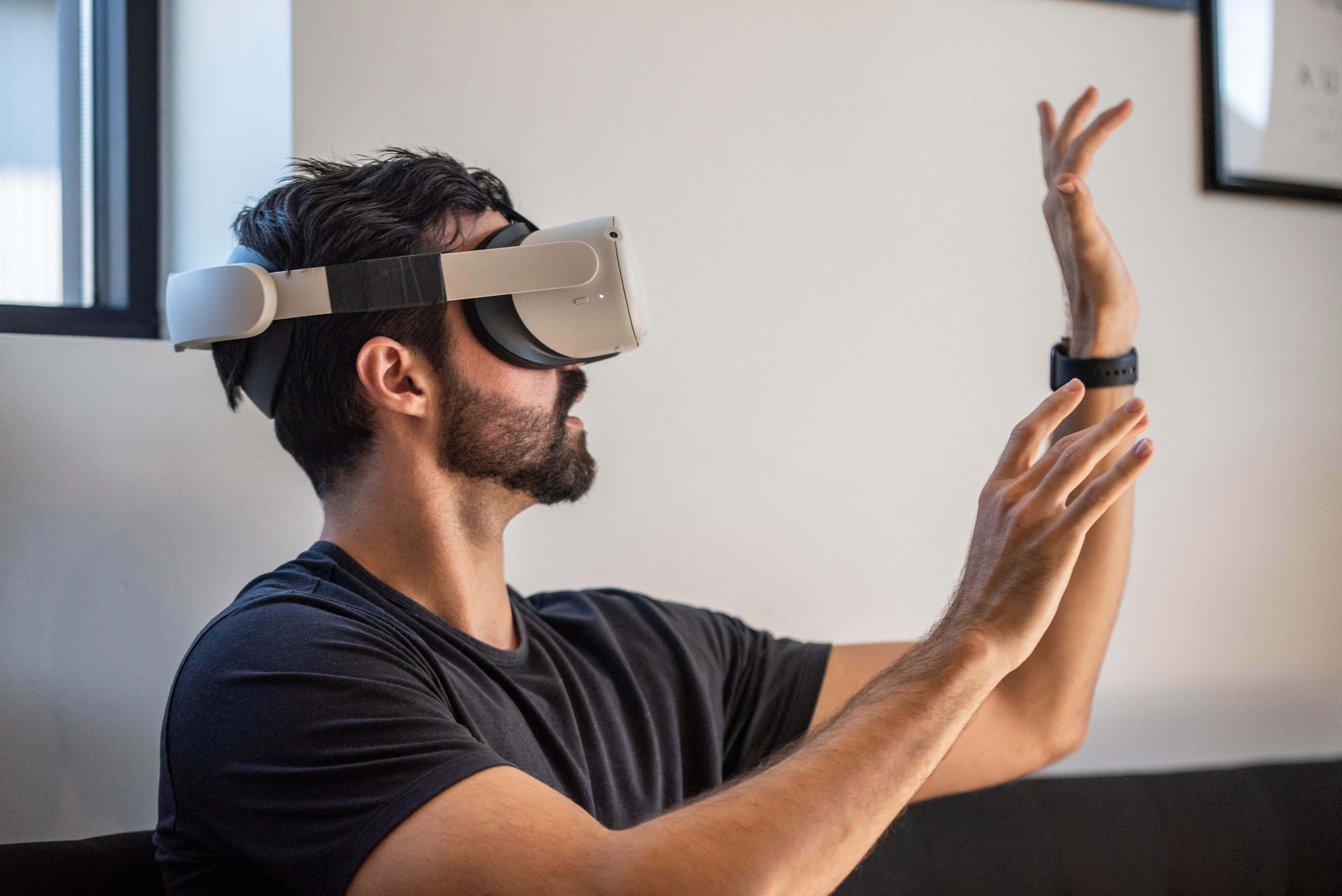
Still, it’s hard to say whether the pandemic has ushered in a new era of virtual reality. Although companies such as Meta and Google are throwing their considerable weight behind VR, its promise has been sputtering along at ground level for decades without ever really taking off.
In 1989, The New York Times described the technology in a front-page story: “Wearing a special helmet and gloves, people would feel immersed in three-dimensional computer-generated worlds and could control the computer by using their hands in a natural manner.” The reporter, Andrew Pollack, wrote, “two people might one day play simulated tennis with each other without leaving their living room.”
Over three decades later, headsets don’t look that different from helmets then, although they’ve gotten a lot more affordable. In 1989, a VR helmet and gloves could cost up to £200,000. Today, one of Meta’s Oculus Quest 2 headsets will set you back £399 (up from £299 before 1 August).
Although a lot of VR growth has been among children whose parents got them Quests for birthdays, Christmas or as plain distractions, Tan is hopeful that VR will be able to spread beyond Gen Z and the hardcore gamers who use it now.
“Even talking to my parents, or people their age, they like VR when they try it, so I think they’ll give it a shot,” Tan says. Until there’s widespread adoption of VR though, he believes that the success of VR dating will depend on word-of-mouth, just as the dating apps Tinder and Bumble became more mainstream once online dating was destigmatised.
“We’ve produced real relationships, and I think that’s proof that it works for people,” he says.
This article originally appeared in The New York Times.

